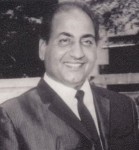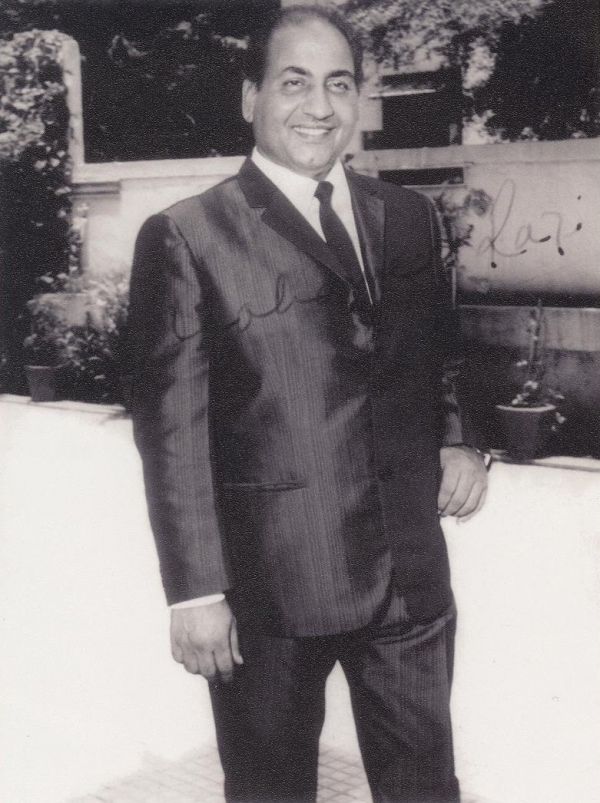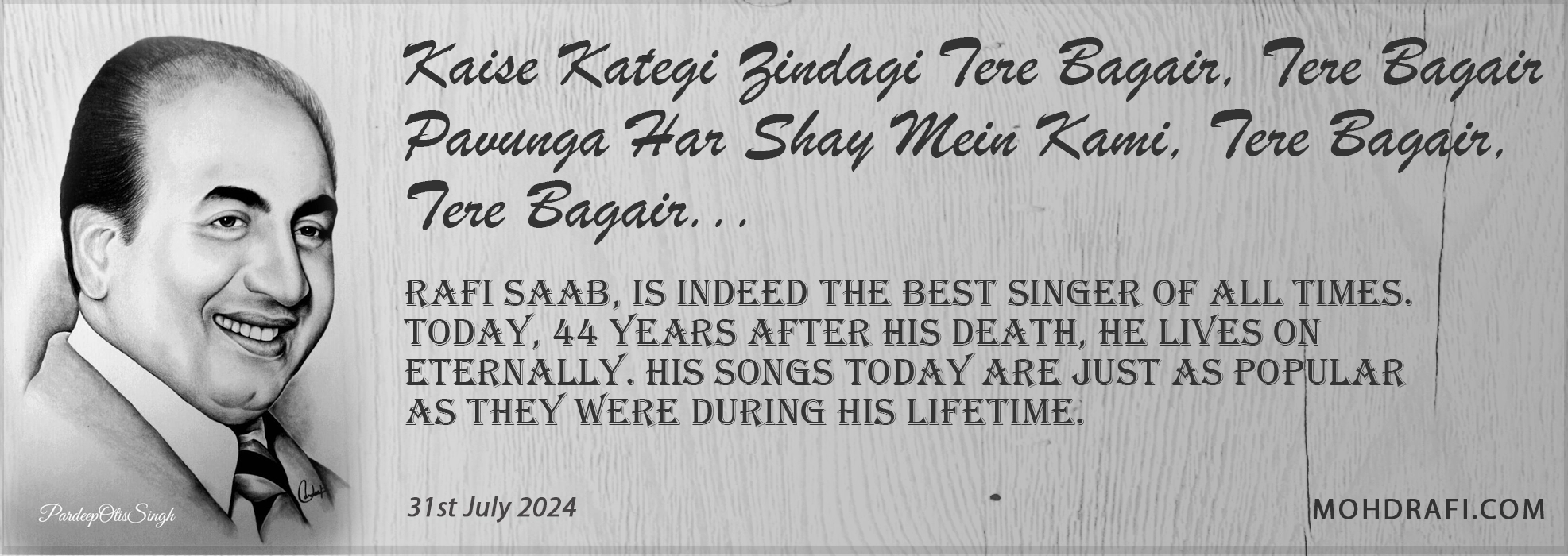When versatility meets gentleness
By Gan Sharma

Mohd Rafi
Hindi film music is firmly embedded in gentleness and romance. It is difficult to listen to the songs of earlier times without the beauty of love creeping into your heart. You go softer than you really are; you imagine what you can’t really have, and for a few beautiful moments, there is a suspension of the usual anxieties and fears that accompany us like shadows throughout our lives.
Dance is something we of the Indian subcontinent perform on stage; it is not something we do at home (except when we practice.) In the Western cultures, a couple would break into a ballroom dance whenever the opportunity presents itself. Today, I wish to write about one form of ballroom dancing – the waltz, and its intimate relationship with two of Mohd. Rafi saab’s very famous songs.
Indeed, the waltz has a very beautiful relationship with music. The Austrian music scholar, Max Graf once wrote, “If there exists a form of music that is a direct expression of sensuality, it is the Viennese waltz….”. If that were true, then there must be a symbiotic relationship between Rafi saab’s singing and the waltz. Both are the quintessence of sensuality; it would not be remiss of me to say that these two songs evokes sensuality of very high order, and both these songs are set to the waltz.
Curiously, both the music directors of these two songs had a superb knowledge of Indian folk music, which is usually not set to the waltz. That simply points to the versatility of these two greats, that’s all.

Mohd Rafi
When a man and a woman are together, in love, and listening to these two songs (or, if they were dancing to the waltz!), their hearts, that are already contained in each other, make their souls meld too. While dancing, they are close together, the man leading (usually) with the gentlest of hints, either cheek to cheek or with her head on his breast, giving into each other their very being. Time stops still even as the beat continues, the cosmos is at a standstill as their feet move in complementarity.
1-2-3, 1-2-3, 1-2-3, the steps go; slowly maybe, or rapid, depending upon the mood, the ambience and the feeling that overpowers the two lovers. It could be very slow, as their bodies, taking direction and commands from their hearts, let the sensuality in through their pores and let the ocean of love wash over them, enveloping them in her smokeless flame. Or, it could be very rapid, frenzied; like the impatience of lovers who have waited for too long for physical union. Yet, the language of this wide range of emotions requires just three alphabets: 1-2-3, 1-2-3, 1-2-3.
Shankar-Jaikishen were the music directors of one of these songs. O-me-re, sha-a-he, khu-baa-an, an-an-an, sang Rafi saab in this beautiful song, his voice and his divinity dancing the waltz all on their own. Imagine this. You are meeting your lover after a long time. The separation has ended; you are in the closest of embraces, all the emotion of the moment contained in the head that is buried on your wildly beating chest. There is no need for a kiss, even; the proximity is enough, the tears of joy and the hunger to drink hers are enough, the wetness of her tears that drenches your shirt is enough. The world has stood still, also crying, to watch this beautiful moment. It is enough.
And then, Rafi saab’s O mere shah-e khubaa plays. Your hand goes around her waist, and the other extends to clasp hers, your cheeks meet, and the feet move of their own accord. You stay in the classic waltz “box” – it is enough, as if the expanse of the universe were a colossal waste, a supreme inefficiency of a wasteful, profligate Supreme. That “box” is enough. She is enough. One cheek each, making love to each other is enough. The other unoccupied cheek is a monstrous superfluosness. Rafi saab is enough.
You could spend hours staying in that “box”. But, having received the bounty of this extravagant Lord, you swing a little, zara jhoom lete hain aap. But you take a few feet on either side, that’s all; the frugality is not miserliness; for where she is, is the only universe worth caring about.
tum ho sehra mein tum gulistaan mein
tum ho zarron mein tum bayaabaan mein
maine tum ko kahaan kahaan dekha
chhupke rehte ho tum rag-e jaan mein.
A fleeting moment you both spare to acknowledge the truth of Shaliendra’s poetry brought to life by SJ’s unparalleled score. How true!! What are the vast spaces when even the tiny gaps between the two of you are utter waste; how can beauty of the unison of your movements compare with even your union?
The song comes to an end in about three minutes. You touch her hair, a questioning touch that asks, “phir se bajaaoon, sweetheart?”, without having to ask. A lateral move against your breast lets you know she is shaking her head “No”. You are surprised. Rafi saab ka gaana hai; khoobsoorat hai, tumhare jaisa, and you say no to repeating the song, you ask, not loudly, but in your heart.
She looks up, and whispers, “Guide”. You smile. She wants to dance the waltz again.
Reaching out, you roll the iPod’s wheel to the appropriate song, and SD Burman da’s genius complements the frenzy of the SJ number with the mildest romance, but nonetheless exhilarating in itself.
Te-re-e, me-re-e, sa-p-ne the song begins. They are painted with the same colours, my darling, you whisper, as the feet move again. 1-2-3, 1-2-3, 1-2-3.
Rafi saab is the only one who can be admitted into such a private moment between man and woman. He stays smiling, at ease, sits on the sofa and watches his children in love. With nary a crease on his brow, he sings:
tere mere dil ka, tai tha ek din milna
jaise bahaar aane par, tai tha phool ka khilna
o mere jeevan saathi…….
After a while, the euphoria subsides a little, and we leave these two beautiful people to their own devices; we have already invaded their privacy enough. But as they send us on our way so that they may drink of each other, in their own way, they don’t ask Rafi saab to leave. He is the gentleness they experience; he is the togetherness they feel; he is their love, he is their union. He is not separate from all these things. Where will he go? He lives in truth, beauty and love.
Just as surely as 3 follows 2, which follows 1, Rafi saab is part of their entire being. He is them melded; he is them fused. He is the waltz, the beat, the rhythm, the dance, the music, and the lovemaking. He is the soul of all that is beautiful.

dear achcal,
thank you very much for your kind words; it means a lot coming from an accomplished writer like yourself!!
Many, many thanks!
Mohan
i second my friend achal ji’s views.
fully….
from the rafi foundation.
Gan (Mohan)
what a lovely piece or writing !!! please accept my belated response to your article. actually after reading your write up i was lot in thoughts, then got up wanting to respond, but something else happened.
i read and re read your article and marvelled at your articulation. you brought back nostalgic memories when you mentioned the S-J composition “o mere shah e khuba”, and then you took me down memory lane one more with “tere mere sapne”- these are two of perhaps the most beautiful romantic numbers rendered by Rafi Saab.
i wish you wrote more often Gan. Please do that.
warm regards
achal rangaswamy
Binuji,
by the way, Ae kaash ke hum from Kabhi Haan Kabhi Naa, sung by Kumar Sanu and music Jatin-Lalit is `inspired’ by Bhanwre ki gunjan…
Binu, sirji, aap sahi hain, like always. Bhanwre ki gunjan is from Kal aaj aur kal __Kapoor khandan film.
cheers
Utthara
Ramesh bhai,
Many thanks…..will try and write more often!
above posts:
which indirectlly sing the tunes for the institution called “shankar and Jaikishan”.
s with j were the innovators in indian bollywood music experimenting and introducing variety music and triumphing at that.
dil ki girah khol do – sung by manna dey and lata for nargis and firoz khan in din aur raat music by sj,
aage bhi jaane na tu : by asha and tuned by another Chaudvin ka chand composer ravi saaheb.
bhave ki gunjan by kishore and tuned by sj i presume….. pls correct me friends.
thanks.
Dear Utthara,
Many, many thanks for the kind words…..it means a lot coming from one whose prose is a misaal of its own!! And thanks for adding to the ballroom dance-Rafi list!!
Mohan
Waltz, originally a vigorous dance, evolved into the dreamy version we know today. And Mohanbhai, your article has captured this dreamy quality. I learnt the meaning of `words dancing before one’s eyes’, literally! Your tribute has made me glide, flow and sway along with your prose. O mere shahequba and Tere mere sapne __ you have given a new dimension to the two of the most-loved songs.Your last sentence has encapsulated the greatness of Rafi in a very rhythmic way.
I am just mentioning 3 songs which are based on ballroom dance: Dil ki girah kholdo, Aage bhi jane na tu and Bhanwre ki gunjan….
Now I am waltzing back to work…
cheers
Utthara
gan ganapati mohan pyaarey,
waah, aap toh khoob likhthey hain. aapkaa nadaazey bayaan – waltz koh bhee doh baar sochnzaa padegaa – rafi sahab key gaaney key sang sang – meri adaikee bhee taruf hojayegi.
waah kyaa zabardast tulnaa kee hai rafi sahab key giakee kee.
kabhee kabhee aap likhney key maamley mein sanyaas leylethey ho – binaa izzazath key ( ha ha ahaaaa )
ammaa aisee bhee kyaa majboori – lkhthey rahiyegaa huzoor – hum bhee thodaasaa mazey looth lelengey aur seekh bhee lenge.
bahut khoob dost.
indeed a classic write up – typical GAN style.
ramesh narain kurpad
Dear NRP, Ananya, others,
Many thanks for your very kind words! Yes, as Binu and others have pointed out, the more you listen to Rafi saab, the more you get out of every piece.
I was fortunate to be in Chennai on Dec 24, Rafi saab’s birthday, where I attended a musical mehfil organized by my very good friend and HUGE Rafi fan Ajay Jain. Chandan from Rafi foundation Chennai sang almost non-stop for four hours; it was a treat for all the senses.
May Rafi saab’s fan-tribe grow!!
Mohan
shabash sharmajee for wonderful and musical write up…rafisaab is the ocean of music…
Dear Mohan,
Every missing second that you have been absent from interactions, has just come alive with this piece. You have taken a somewhat non-traditional format to describe Rafi Saahab’s versatility, in union with SJ and Burman Da. Both in the end go on to deliver the same message though – that when it comes to experiment with newer ideas, Rafi Saahab somehow would engulf the theme in entirety and deliver it to perfection.
I am not as well versed with waltz as some of you but if this is what it conveys through moods, beats, tunes…well, you have opened yet another chapter of the maestro. I especially like it because these are male solos but once one is through with the write-up, you do come out with a sense of participation. Waltz does not remain a solo performance a-la Bharatanatyam. The proposal emanates from the male but gradually meanders into complimentary steps, embrace and union. The couple waltz away to glory, so to say.
Super, Mohan. Just try to bring more of these theme-within-a-theme concepts to the fore. It gives an already well-described and delivered some additional dimensions.
Padmanabhan NR
Let me bring to life a trivia associated with “O Mere Shah Ae Khubaan”……Legend has it that Mirza Ghalib offered his entire Divaan in return of a beautiful couplet by Momin Khan Momin….the couplet was “tum mere pass hotey ho, goya jab koi doosran nahin hota”.
This is a well documented fact. I have provided the source at the end.
This couplet was beautifully adopted by Hasrat Jaipuri and composed by SJ. What a beautiful rendition by Rafisaab. In a way its a tribute by a Genius ” Rafi Saab” to another Genius “Mirza” who recognised the gem from a otherwise little known poet called Momin Khan Momin. Aren’t we blessed to be witnessing such greatness? I only wonder.
Very well written piece. What great songs and compositions both of them. Great work Rafi academy.
http://www.columbia.edu/itc/mealac/pritchett/00ghalib/005/5_01.html?#hali
Ta,
two points…..connected with the mood’s when listening songs of god’s emissary.
as told by playback singer shabbir kumar…
” after a tiring day one retires in solitude and just turns the “on” button for rafi saaheb’s songs…
the bliss one receive is un imaginable..”
and – whichever mood you are in, there is a ready mohd rafi song……
i will leave this world as the number one mohd rafi sahib had said and he “lived” to see it…….
two points…..connected with the mood’s when listening songs of god’s emissary.
as told by playback singer shabbir kumar…
” after a tiring day one retires in solitude and just turns the “on” button for rafi saaheb’s songs…
the bliss one receive is un imaginable..”
and – whichever mood you are in, there is a ready mohd rafi song……
i will leave this world as the number one mohd rafi sahib had said and he lived to see it…….
Further to my earlier comment, the closest representation in Hindustani classical music to the waltz is the Dadra taal, which has six beats in two divisions of three, each division accented by an alternate clap and wave.
Thus, when dancing the waltz, the forward movement of the male would start with the clap, the female’s with the wave.
Thanks!!
Gan Sharma (Mohan)
Many thanks to all who liked the article!! Much appreciated.
Just a quick point of clarification. The waltz has nothing to do the the raag of the song; the former is set to a beat, the latter represents a tune. There are clearly other songs that are set to the waltz; it may be a good idea to list some of them!!
Many thanks for participating.
Gan Sharma (Mohan).
A good analysis. Some more perhaps better examples should also be given to help fans like me understand this beautiful analogy. Do delve on Dev Saab’s chemistry with Rafi Saab, which created masterpieces…Thanks.
Mohan,
Unique. No body has so far tried this sort of description of two beautiful songs. When Rafiji’s songs were played, as admitted by Biswajeet, there was no need for any body to act, as Rafi Saab acted and expressed all the feelings in his singing. The actors had to just stand there and lip synch.
Congratulations. Keep it up.
The raag bhairavi is Indian equivalent of Waltz.Jaiikishan of SJ loves bhairavi so much I heard he named one of his daughters Bhairavi.I liked the article but I wish the author has chosen a different number of SJ as an example of Rafi giving life to waltz for ex the dream song from Humrahi,Suraj,Lat Saheb,An evening in Paris to name a few.
You have weaved a magical spell with your words as mesmerising as the songs showcased of the great legend…..
Congratulations !!
Dear Gan,
Two beautiful Rafi songs which deserve a treatment that is intimate and full of
love. You have evoked the very imageries the songs convey and don’t, in your own inimitable detailing.
This is a review beyond the songs in discussion. It’s biographical to every loving soul. Congratulations !!
Nagesh
waltz a write up! beautifully written saab,your description is ultimate.
A TRULY diffrent type of song story whose central narrator is mohd rafi.
rightly said rafi is the soul of all that is beautiful…..
would re – read it in detail once more… gan sharm saaheb.
thanks….